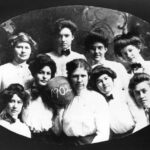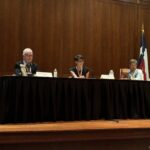Reading Ahead
Literacy First is teaching Austin how to read—one child at a time.

Just a few days after the new year, more than 100 Americorps members sit in a room for an intensive, 50-hour training program to become literacy tutors. They’re shown several random symbols and given a sound to associate with each one. Then, they have to read them.
“It feels impossible,” says Hiren Mistry, a second-year tutor and University of Buffalo graduate. It’s the feeling many children have when they’re asked to sound out letters they simply don’t know. “When you know how to read, it’s easy to forget what it felt like trying to learn.”
Sixty-two percent of Texas students cannot proficiently read by fourth grade. And Mary Ellen Isaacs, PhD ’96, the director of Literacy First, says the problem starts even earlier than that. “Children that aren’t reading well by third grade are four times more likely to drop out of high school,” she says.
With crowded classrooms and loaded curriculums, Isaacs says teachers can’t close the reading gap on their own. That’s where Literacy First steps in. The UT-based program partners with Americorps to provide tutors to 2,200 students across Austin. It doesn’t take long to help them achieve literacy; on average, students only need eight to 10 weeks with Literacy First to reach grade-level reading goals.
Founded in 1994 through the Charles A. Dana Center, Literacy First has seen several changes in its 23 years. While the program originally relied heavily on UT students as part-time tutors, over time Isaacs initiated a shift to full-time tutors only (15-20 percent of whom are UT alumni). The program also used to offer tutoring to all elementary grades, and other activities such as parent workshops. But by 2009, Isaacs decided to narrow the program’s focus. “We learned that our biggest impact was the one-to-one work we did,” Isaacs says.
The program began shifting into daily, intensive tutoring sessions (rather than twice-weekly) and a focus on kindergarten through second grade. The impact was immediate. The same number of tutors began to see twice as many kids, and the narrowed grade focus allowed the program to scale. With the changes accomplished in 2012, Literacy First rapidly grew from serving five Austin area schools to 32 within four years.
For Isaacs, the impact extends beyond tutoring. A former reading and special education teacher herself, she knows the impact teachers can have. About 20 percent of Literacy First tutors go on to become teachers. “After serving in the schools, a lot of them realize they have the heart of a teacher,” she says. “They go in with their eyes open.” The program helps tutors get their teaching certification—and they tend to outlast the national average of three years for teacher burnout.
“I think we’re a great unsung example of the university developing something with its resources and intellectual capital that faces outward to the community and makes a difference,” Isaacs says.
Isabel Ramirez, BA ’15, is one of the 18 UT graduates tutoring with Literacy First this year. During a quick break, she says the satisfaction of seeing her students learn and grow brought her back for a second year. And as a bilingual tutor in one of the only fully bilingual literacy programs in the state, she also feels it’s important to help the Latino community. We don’t get to speak very long before she has to take on another student. Each tutor works with approximately 10 kids throughout the school day, in 20-30 minute sessions each. Soon, all three tutors at this school have students working on their lessons.
All around the room, the praises ring out. “You read 50 letters in one minute!” Mistry exclaims to his student. He later tells me she had started out identifying just four letters. He high-fives her and they clear the flash cards off the table to make room for her progress journal, where she will color in a graph showing how many words or letters she’s learned. It always brings a smile.














1 Comment